in building, the term applied to constructions made of bricks. The tools and implements employed by the bricklayer are:—the trowel for spreading the mortar; the plumb-rule to keep the work perpendicular, or in the case of an inclined or battering wall, to a regular batter, for the plumb-rule may be made to suit any required inclination; the spirit-level to keep the work horizontal, often used in conjunction with a straight-edge in order to test a greater length; and the gauge-rod with the brick-courses marked on it. The quoins or angles are first built up with the aid of the gauge-rod, and the intermediate work is kept regular by means of the line and line pins fixed in the joints. The raker, jointer, pointing rule and Frenchman are used in pointing joints, the pointing staff being held on a small board called the hawk. For roughly cutting bricks the large trowel is used; for neater work such as facings, the bolster and club-hammer; the cold chisel is for general cutting away, and for chases and holes. When bricks require to be cut, the work is set out with the square, bevel and compasses. If the brick to be shaped is a hard one it is placed on a V-shaped cutting block, an incision made where desired with the tin saw, and after the bolster and club-hammer have removed the portion of the brick, the scutch, really a small axe, is used to hack off the rough parts. For cutting soft bricks, such as rubbers and malms, a frame saw with a blade of soft iron wire is used, and the face is brought to a true surface on the rubbing stone, a slab of Yorkshire stone.
In ordinary practice a scaffold is carried up with the walls and made to rest on them. Having built up as high as he can reach from the ground, the scaffolder erects a scaffold with standards, ledgers and putlogs to carry the scaffold boards (see Scaffold, Scaffolding). Bricks are carried to the scaffold on a hod which holds twenty bricks, or they may be hoisted in baskets or boxes by means of a pulley and fall, or may be raised in larger numbers by a crane. The mortar is taken up in a hod or hoisted in pails and deposited on ledged boards about 3 ft. square, placed on the scaffold at convenient distances apart along the line of work. The bricks are piled on the scaffold between the mortar boards, leaving a clear way against the wall for the bricklayers to move along. The workman, beginning at the extreme left of his section, or at a quoin, advances to the right, carefully keeping to his line and frequently testing his work with the plumb-rule, spirit-level and straight-edge, until he reaches another angle, or the end of his section. The pointing is sometimes finished off as the work proceeds, but in other cases the joints are left open until the completion, when the work is pointed down, perhaps in a different mortar. When the wall has reached a height from the scaffold beyond which the workman cannot conveniently reach, the scaffolding is raised and the work continued in this manner from the new level.

It is most important that the brickwork be kept perfectly plumb, and that every course be perfectly horizontal or level, both longitudinally and transversely. Strictest attention should be paid to the levelling of the lowest course of footings of a wall, for any irregularity will necessitate the inequality being made up with mortar in the courses above, thus inducing a liability for the wall to settle unequally, and so perpetuate the infirmity. To save the trouble of keeping the plumb-rule and level constantly in his hands and yet ensure correct work, the bricklayer, on clearing the footings of a wall, builds up six or eight courses of bricks at the external angles (see fig. 1), which he carefully plumbs and levels across. These form a gauge for the intervening work, a line being tightly strained between and fixed with steel pins to each angle at a level with the top of the next course to be laid, and with this he makes his work range. If, however, the length between the quoins be great, the line will of course sag, and it must, therefore, be carefully supported at intervals to the proper level. Care must be taken to keep the "perpends," or vertical joints, one immediately over the other. Having been carried up three or four courses to a level with the guidance of the line which is raised course by course, the work should be proved with the level and plumb-rule, particularly with the latter at the quoins and reveals, as well as over the face. A smart tap with the end of the handle of the trowel will suffice to make a brick yield what little it may be out of truth, while the work is green, and not injure it. The work of an efficient craftsman, however, will need but little adjustment.
For every wall of more than one brick (9 in) thick, two men should be employed at the same time, one on the outside and the [v.04 p.0522]other inside; one man cannot do justice from one side to even a 14-in. wall. When the wall can be approached from one side only, the work is said to be executed "overhand." In work circular on plan, besides the level and plumb-rule, a gauge mould or template, or a ranging trammel—a rod working on a pivot at the centre of the curve, and in length equalling the radius—must be used for every course, as it is evident that the line and pins cannot be applied to this in the manner just described.
Bricks should not be merely laid, but each should be placed frog upwards, and rubbed and pressed firmly down in such a manner as to secure absolute adhesion, and force the mortar into joints. Every brick should be well wetted before it is laid, especially in hot dry weather, in order to wash off the dust from its surface, and to obtain more complete adhesion, and prevent it from absorbing water from the mortar in which it is bedded. The bricks are wetted either by the bricklayer dipping them in water as he uses them, or by water being thrown or sprinkled on them as they lie piled on the scaffold. In bricklaying with quick-setting cements an ample use of water is of even more importance.
All the walls of a building that are to sustain the same floors and the same roof, should be carried up simultaneously; in no circumstances should more be done in one part than can be reached from the same scaffold, until all the walls are brought up to the same height. Where it is necessary for any reason to leave a portion of the wall at a certain level while carrying up the adjoining work the latter should be racked back, i.e. left in steps as shown in fig. 7, and not carried up vertically with merely the toothing necessary for the bond.

Buildings in exposed situations are frequently built with cavity-walls, consisting of the inside or main walls with an outer skin Hollow walls. usually half a brick thick, separated from the former by a cavity of 2 or 3 in. (fig. 2). The two walls are tied together at frequent intervals by iron or stoneware ties, each having a bend or twist in the centre, which prevents the transmission of water to the inner wall. All water, therefore, which penetrates the outer wall drops to the base of the cavity, and trickles out through gratings provided for the purpose a few inches above the ground level. The base of the cavity should be taken down a course or two below the level of the damp-proof course. The ties are placed about 3 ft. apart horizontally, with 12 or 18 in. vertical intervals; they are about 8 in. long and ¾ in. wide. It is considered preferable by some architects and builders to place the thicker wall on the outside. This course, however, allows the main wall to be attacked by the weather, whereas the former method provides for its protection by a screen of brickwork. Where door and window frames occur in hollow walls, it is of the utmost importance that a proper lead or other flashing be built in, shaped so as to throw off on each side, clear of the frames and main wall, the water which may penetrate the outer shell. While building the wall it is very essential to ensure that the cavity and ties be kept clean and free from rubbish or mortar, and for this purpose a wisp of straw or a narrow board, is laid on the ties where the bricklayer is working, to catch any material that may be inadvertently dropped, this protection being raised as the work proceeds. A hollow wall tends to keep the building dry internally and the temperature equable, but it has the disadvantage of harbouring vermin, unless care be taken to ensure their exclusion. The top of the wall is usually sealed with brickwork to prevent vermin or rubbish finding its way into the cavity. Air gratings should be introduced here to allow of air circulating through the cavity; they also facilitate drying out after rain.
Hollow walls are not much used in London for two reasons, the first being that, owing to the protection from the weather afforded by surrounding buildings, one of the main reasons for their use is gone, and the other that the expense is greatly increased, owing to the authorities ignoring the outer shell and requiring the main wall to be of the full thickness stipulated in schedule I. of London Building Act 1894. Many English provincial authorities in determining the thickness of a cavity-wall, take the outer portion into consideration.
In London and the surrounding counties, brickwork is measured by the rod of 16½ ft. square, 1½ bricks in thickness. A rod of brickwork Materials and labour. gauged four courses to a foot with bricks 8¾ in. long, 4¼ in. wide, and 2¾ in thick, and joints ¼ in. in thickness, will require 4356 bricks, and the number will vary as the bricks are above or below the average size, and as the joints are made thinner or thicker. The quantity of mortar, also, will evidently be affected by the latter consideration, but in London it is generally reckoned at 50 cub. ft. for a ¼-in. joint, to 72 cub. ft. for a joint ⅜ in. thick. To these figures must be added an allowance of about 11 cub. ft. if the bricks are formed with frogs or hollows. Bricks weigh about 7 lb each; they are bought and sold by the thousand, which quantity weighs about 62 cwt. The weight of a rod of brickwork is 13½-15 tons, work in cement mortar being heavier than that executed in lime. Seven bricks are required to face a sq. ft.; 1 ft. of reduced brickwork—1½ bricks thick—will require 16 bricks. The number of bricks laid by a workman in a day of eight hours varies considerably with the description of work, but on straight walling a man will lay an average of 500 in a day.
The absorbent properties of bricks vary considerably with the kind of brick. The ordinary London stock of good quality should Varieties of bricks. not have absorbed, after twenty-four hours' soaking, more than one-fifth of its bulk. Inferior bricks will absorb as much as a third. The Romans were great users of bricks, both burnt and sun-dried. At the decline of the Roman empire, the art of brickmaking fell into disuse, but after the lapse of some centuries it was revived, and the ancient architecture of Italy shows many fine examples of brick and terra-cotta work. The scarcity of stone in the Netherlands led to the development of a brick architecture, and fine examples of brickwork abound in the Low Countries. The Romans seem to have introduced brickmaking into England, and specimens of the large thin bricks, which they used chiefly as a bond for rubble masonry, may be seen in the many remains of Roman buildings scattered about that country. During the reigns of the early Tudor kings the art of brickmaking arrived at great perfection, and some of the finest known specimens of ornamental brickwork are to be found among the work of this period. The rebuilding of London after the Great Fire of 1666 gave considerable impetus to brickmaking, most of the new buildings being of brick, and a statute was passed regulating the number of bricks in the thickness of the walls of the several rates of dwelling-houses.
The many names given to the different qualities of bricks in various parts of Great Britain are most confusing, but the following are those generally in use:—
Stocks, hard, sound, well-burnt bricks, used for all ordinary purposes.
Hard Stocks, sound but over-burnt, used in footings to walls and other positions where good appearance is not required.
Shippers, sound, hard-burnt bricks of imperfect shape. Obtain their name from being much used as ballast for ships.
Rubbers or Cutters, sandy in composition and suitable for cutting with a wire saw and rubbing to shape on the stone slab.
Grizzles, sound and of fair shape, but under-burnt; used for inferior work, and in cases where they are not liable to be heavily loaded.
Place-bricks, under-burnt and defective; used for temporary work.
Chuffs, cracked and defective in shape and badly burnt. [v.04 p.0523] Burrs, lumps which have vitrified or run together in the burning; used for rough walling, garden work, &c.
Pressed bricks, moulded under hydraulic pressure, and much used for facing work. They usually have a deep frog or hollow on one or both horizontal faces, which reduces the weight of the brick and forms an excellent key for the mortar.
Blue bricks, chiefly made in South Staffordshire and North Wales. They are used in engineering work, and where great compressional resistance is needed, as they are vitrified throughout, hard, heavy, impervious and very durable. Blue bricks of special shape may be had for paving, channelling and coping.
Fire-bricks, withstanding great heat, used in connexion with furnaces. They should always be laid with fire-clay in place of lime or cement mortar.
Glazed bricks, either salt-glazed or enamelled. The former, brown in colour, are glazed by throwing salt on the bricks in the kiln. The latter are dipped into a slip of the required colour before being burnt, and are used for decorative and sanitary purposes, and where reflected light is required.
Moulded bricks, for cornices, string courses, plinths, labels and copings. They are made in the different classes to many patterns; and on account of their greater durability, and the saving of the labour of cutting, are preferable in many cases to rubbers. For sewer work and arches, bricks shaped as voussoirs are supplied.
The strength of brickwork varies very considerably according to the kind of brick used, the position in which it is used, the kind and Strength of brickwork. quality of the lime or cement mortar, and above all the quality of the workmanship. The results of experiments with short walls carried out in 1896-1897 by the Royal Institute of British Architects to determine the average loads per sq. ft. at which crushing took place, may be briefly summarized as follows: Stock brickwork in lime mortar crushed under a pressure of 18.63 tons per sq. ft., and in cement mortar under 39.29 tons per sq. ft. Gault brickwork in lime mortar crushed at 31.14 tons, and in cement mortar at 51.34 tons. Fletton brickwork in lime crushed under a load of 30.68 tons, in cement under 56.25 tons. Leicester red brickwork in lime mortar crushed at 45.36 tons per sq. ft., in cement mortar at 83.36 tons. Staffordshire blue brick work in lime mortar crushed at 114.34 tons, and in cement mortar at 135.43 tons.
The height of a brick pier should not exceed twelve times its least width. The London Building Act in the first schedule prescribes that in buildings not public, or of the warehouse class, in no storey shall any external or party walls exceed in height sixteen times the thickness. In buildings of the warehouse class, the height of these walls shall not exceed fourteen times the thickness.
In exposed situations it is necessary to strengthen the buildings by increasing the thickness of walls and parapets, and to provide heavier copings and flashings. Special precautions, too, must be observed in the fixing of copings, chimney pots, ridges and hips. The greatest wind pressure experienced in England may be taken at 56 lb on a sq. ft., but this is only in the most exposed positions in the country or on a sea front. Forty pounds is a sufficient allowance in most cases, and where there is protection by surrounding trees or buildings 28 lb per sq. ft. is all that needs to be provided against.
In mixing mortar, particular attention must be paid to the sand with which the lime or cement is mixed. The best sand is that Mortar. obtained from the pit, being sharp and angular. It is, however, liable to be mixed with clay or earth, which must be washed away before the sand is used. Gravel found mixed with it must be removed by screening or sifting. River sand is frequently used, but is not so good as pit sand on account of the particles being rubbed smooth by attrition. Sea sand is objectionable for two reasons; it cannot be altogether freed from a saline taint, and if it is used the salt attracts moisture and is liable to keep the brickwork permanently damp. The particles, moreover, are generally rounded by attrition, caused by the movement of the sea, which makes it less efficient for mortar than if they retained their original angular forms. Blue or black mortar, often used for pointing the joints of external brickwork on account of its greater durability, is made by using foundry sand or smith's ashes instead of ordinary sand. There are many other substitutes for the ordinary sand. As an example, fine stone grit may be used with advantage. Thoroughly burnt clay or ballast, old bricks, clinkers and cinders, ground to a uniform size and screened from dust, also make excellent substitutes.
Fat limes (that is, limes which are pure, as opposed to "hydraulic" limes which are burnt from limestone containing some clay) should not be used for mortar; they are slow-setting, and there is a liability for some of the mortar, where there is not a free access of air to assist the setting, remaining soft for some considerable period, often months, thus causing unequal settlement and possibly failure. Grey stone lime is feebly hydraulic, and makes a good mortar for ordinary work. It, however, decays under the influence of the weather, and it is, therefore, advisable to point the external face of the work in blue ash or cement mortar, in order to obtain greater durability. It should never be used in foundation work, or where exposed to wet. Lias lime is hydraulic, that is, it will set firm under water. It should be used in all good class work, where Portland cement is not desired.
Of the various cements used in building, it is necessary only to mention three as being applicable to use for mortar. The first of these is Portland cement, which has sprung into very general use, not only for work where extra strength and durability are required, and for underground work, but also in general building where a small extra cost is not objected to. Ordinary lime mortar may have its strength considerably enhanced by the addition of a small proportion of Portland cement. Roman cement is rarely used for mortar, but is useful in some cases on account of the rapidity with which it sets, usually becoming hard about fifteen minutes after mixing. It is useful in tidal work and embankments, and constructions under water. It has about one-third of the strength of Portland cement, by which it is now almost entirely supplanted. Selenitic cement or lime, invented by Major-General H. Y. D. Scott (1822-1883), is lias lime, to which a small proportion of plaster of Paris has been added with the object of suppressing the action of slaking and inducing quicker setting. If carefully mixed in accordance with the instructions issued by the manufacturers, it will take a much larger proportion of sand than ordinary lime.
Lime should be slaked before being made into mortar. The lime is measured out, deposited in a heap on a wooden "bank" or platform, and after being well watered is covered with the correct proportion of sand. This retains the heat and moisture necessary to thorough slaking; the time required for this operation depends on the variety of the lime, but usually it is from a few hours to one and a half days. If the mixing is to be done by hand the materials must be screened to remove any unslaked lumps of lime. The occurrence of these may be prevented by grinding the lime shortly before use. The mass should then be well "larried," i.e. mixed together with the aid of a long-handled rake called the "larry." Lime mortar should be tempered for at least two days, roughly covered up with sacks or other material. Before being used it must be again turned over and well mixed together. Portland and Roman cement mortars must be mixed as required on account of their quick-setting properties. In the case of Portland cement mortar, a quantity sufficient only for the day's use should be "knocked up," but with Roman cement fresh mixtures must be made several times a day, as near as possible to the place of using. Cement mortars should never be worked up after setting has taken place. Care should be taken to obtain the proper consistency, which is a stiff paste. If the mortar be too thick, extra labour is involved in its use, and much time wasted. If it be so thin as to run easily from the trowel, a longer time is taken in setting, and the wall is liable to settle; also there is danger that the lime or cement will be killed by the excess of water, or at least have its binding power affected. It is not advisable to carry out work when the temperature is below freezing point, but in urgent cases bricklaying may be successfully done by using unslaked lime mortar. The mortar must be prepared in small quantities immediately before being used, so that binding action takes place before it cools. When the wall is left at night time the top course should be covered up to prevent the penetration of rain into the work, which would then be destroyed by the action of frost. Bricks used during frosty weather should be quite dry, and those that have been exposed to rain or frost should never be employed. The question whether there is any limit to bricklayers' work in frost is still an open one. Among the members of the Norwegian Society of Engineers and Architects, at whose meetings the subject has been frequently discussed, that limit is variously estimated at between -6° to -8° Réaumur (18½° to 14° Fahr.) and -12° to -15° Réaumur (5° above to 1¾° below zero Fahr.). It has been proved by hydraulic tests that good bricklayers' work can be executed at the latter minimum. The conviction is held that the variations in the opinions held on this subject are attributable to the degree of care bestowed on the preparation of the mortar. It is generally agreed, however, that from a practical point of view, bricklaying should not be carried on at temperatures lower than -8° to -10° Réaumur (14° to 9½° Fahr.), for as the thermometer falls the expense of building is greatly increased, owing to a larger proportion of lime being required.
For grey lime mortar the usual proportion is one part of lime to two or three parts of sand; lias lime mortar is mixed in similar proportions, except for work below ground, when equal quantities of lime and sand should be used. Portland cement mortar is usually in the proportions of one to three, or five, of sand; good results are obtained with lime mortar fortified with cement as follows:—one part slaked lime, one part Portland cement, and seven parts sand. Roman cement mortar should consist of one or one and a half parts of cement to one part of sand. Selenitic lime mortar is usually in the proportions of one to four or five, and must be mixed in a particular manner, the lime being first ground in water in the mortar mill, and the sand gradually added. Blue or black mortar contains equal parts of foundry ashes and lime; but is improved by the addition of a proportion of cement. For setting fire-bricks fire-clay is always used. Pargetting for rendering inside chimney flues is made of one part of lime with three parts of cow dung free from straw or litter. No efficient substitute has been found for this mixture, which should be used fresh. A mortar that has found approval for tall chimney shafts is composed by grinding in a mortar-mill one part of blue lias lime with one part each of sand and foundry ashes. In the external walls of the Albert Hall the mortar used was one part Portland cement, one part grey Burham lime and six parts pit sand. The lime was slaked twenty-four hours, and after being mixed [v.04 p.0524]with the sand for ten minutes the cement was added and the whole ground for one minute; the stuff was prepared in quantities only sufficient for immediate use. The by-laws dated 1891, made by the London County Council under section 16 of the Metropolis Management and Building Acts Amendment Act 1878, require the proportions of lime mortar to be one to three of sand or grit, and for cement mortar one to four. Clean soft water only should be used for the purpose of making mortar.
Grout is thin liquid mortar, and is legitimately used in gauged arches and other work when fine joints are desired. In ordinary work it is sometimes used every four or five courses to fill up any spaces that may have been inadvertently left between the bricks. This at the best is but doing with grout what should be done with mortar in the operation of laying the bricks; and filling or flushing up every course with mortar requires but little additional exertion and is far preferable. The use of grout is, therefore, a sign of inefficient workmanship, and should not be countenanced in good work. It is liable, moreover, to ooze out and stain the face of the brickwork.
Lime putty is pure slaked lime. It is prepared or "run," as it is termed, in a wooden tub or bin, and should be made as long a time as possible before being used; at least three weeks should elapse between preparation and use.
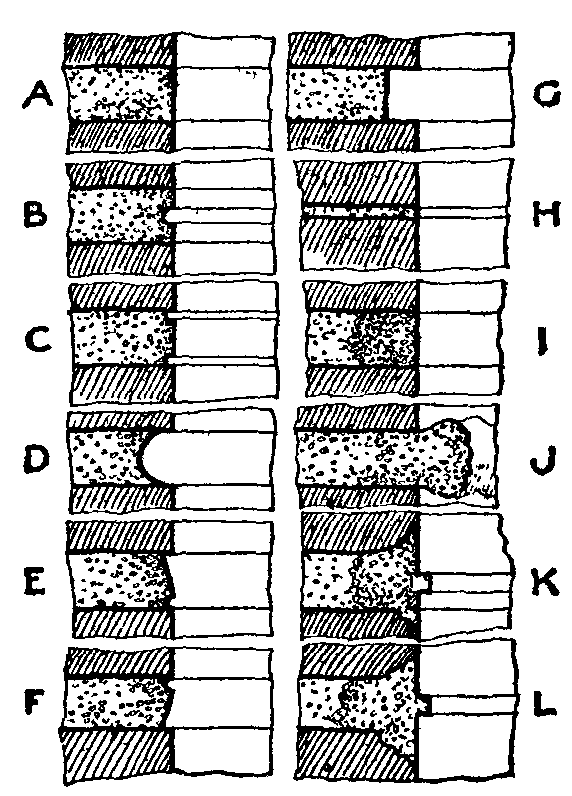
The pointing of a wall, as previously mentioned, is done either with the bricklaying or at the completion of the work. If the Pointing. pointing is to be of the same mortar as the rest of the work, it would probably greatly facilitate matters to finish off the work at one operation with the bricklaying, but where, as in many cases, the pointing is required to be executed in a more durable mortar, this would be done as the scaffold is taken down at the completion of the building, the joints being raked out by the bricklayer to a depth of ½ or ¾ in. By the latter method the whole face of the work is kept uniform in appearance. The different forms of joints in general use are clearly shown in fig. 3. Flat or flush joints (A) are formed by pressing the protruding mortar back flush with the face of the brickwork. This joint is commonly used for walls intended to be coated with distemper or limewhite. The flat joint jointed (two forms, B and C) is a development of the flush joint. In order to increase the density and thereby enhance the durability of the mortar, a semicircular groove is formed along the centre, or one on each side of the joint, with an iron jointer and straight-edge. Another form, rarely used, is the keyed joint shown at D, the whole width of the joint in this case being treated with the curved key. Struck or bevelled, or weathered, joints have the upper portion pressed back with the trowel to form a sloping surface, which throws off the wet. The lower edge is cut off with the trowel to a straight edge. This joint is in very common use for new work. Ignorant workmen frequently make the slope in the opposite direction (F), thus forming a ledge on the brick; this catches the water, which on being frozen rapidly causes the disintegration of the upper portion of the brick and of the joint itself. With recessed jointing, not much used, a deep shadow may be obtained. This form of joint, illustrated in G, is open to very serious objections, for it encourages the soaking of the brick with rain instead of throwing off the wet, as it seems the natural function of good pointing, and this, besides causing undue dampness in the wall, renders it liable to damage by frost. It also leaves the arrises of the bricks unprotected and liable to be damaged, and from its deep recessed form does not make for stability in the work. Gauged work has very thin joints, as shown at H, formed by dipping the side of the brick in white lime putty. The sketch I shows a joint raked out and filled in with pointing mortar to form a flush joint, or it may be finished in any of the preceding forms. Where the wall is to be plastered the joints are either left open or raked out, or the superfluous mortar may be left protruding as shown at J. By either method an excellent key is obtained, to which the rendering firmly adheres. In tuck pointing (K) the joints are raked out and stopped, i.e. filled in flush with mortar coloured to match the brickwork. The face of the wall is then rubbed over with a soft brick of the same colour, or the work may be coloured with pigment. A narrow groove is then cut in the joints, and the mortar allowed to set. White lime putty is next filled into the groove, being pressed on with a jointing tool, leaving a white joint ⅛ to ¼ in. wide, and with a projection of about 1/16 in. beyond the face of the work. This method is not a good or a durable one, and should only be adopted in old work when the edges of the bricks are broken or irregular. In bastard tuck pointing (L), the ridge, instead of being in white lime putty, is formed of the stopping mortar itself.
Footings, as will be seen on reference to fig. 1, are the wide courses of brickwork at the base or foot of a wall. They serve to spread Footings. the pressure over a larger area of ground, offsets 2¼ in. wide being made on each side of the wall until a width equal to double the thickness of the wall is reached. Thus in a wall 13½ in. (1½ bricks) thick, this bottom course would be 2 ft. 3 in. (3 bricks) wide. It is preferable for greater strength to double the lowest course. The foundation bed of concrete then spreading out an additional 6 in. on each side brings the width of the surface bearing on the ground to 3 ft. 3 in. The London Building Act requires the projection of concrete on each side of the brickwork to be only 4 in., but a projection of 6 in. is generally made to allow for easy working. Footings should be built with hard bricks laid principally as headers; stretchers, if necessary, should be placed in the middle of the wall.

Bond in brickwork is the arrangement by which the bricks of every course cover the joints of those in the course below it, and so Bonding. tend to make the whole mass or combination of bricks act as much together, or as dependently one upon another, as possible. The workmen should be strictly supervised as they proceed with the work, for many failures are due to their ignorance or carelessness in this particular. The object of bonding will be understood by reference to fig. 4. Here it is evident from the arrangement of the bricks that any weight placed on the topmost brick (a) is carried down and borne alike in every course; in this way the weight on each brick is distributed over an area increasing with every course. But this forms a longitudinal bond only, which cannot extend its influence beyond the width of the brick; and a wall of one brick and a half, or two bricks, thick, built in this manner, would in effect consist of three or four half brick thick walls acting independently of each other. If the bricks were turned so as to show their short sides or ends in front instead of their long ones, certainly a compact wall of a whole brick thick, instead of half a brick, would be produced, and while the thickness of the wall would be double, the longitudinal bond would be shortened by one-half: a wall of any great thickness built in this manner would necessarily be composed of so many independent one-brick walls. To produce a transverse and yet preserve a true longitudinal bond, the bricks are laid in a definite arrangement of stretchers and headers.
In this and following illustration of bond in brickwork the position of bricks in the second course is indicated by dotted lines.
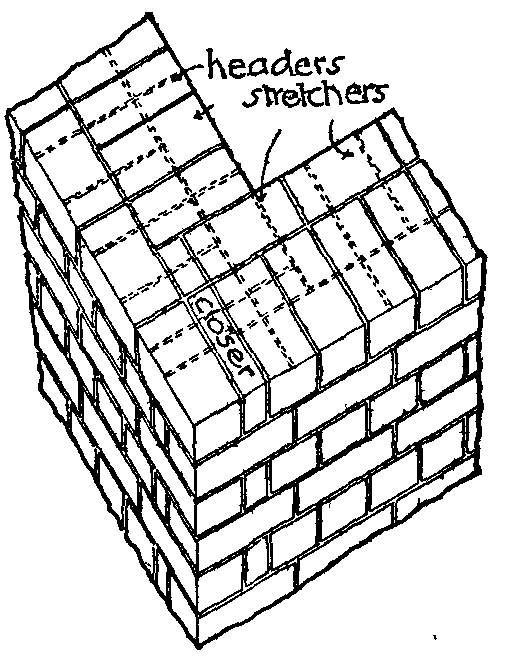
In "English bond" (fig. 5), rightly considered the most perfect in use, the bricks are laid in alternate courses of headers and stretchers, thus combining the advantages of the two previous modes of arrangement. A reference to fig. 5 will show how the process of bonding is pursued in a wall one and a half bricks in thickness, and how the quoins are formed. In walls which are a multiple of a whole brick, the appearance of the same course is similar on the elevations of the front and back faces, but in walls where an odd half brick must be used to make up the thickness, as is the case in the illustration, the appearance of the opposite sides of a course is inverted. The example illustrates the principle of English bond; thicker walls are constructed in the same manner by an extension of the same methods. It will be observed that portions of a brick have to be inserted near a vertical end or a quoin, in order to start the regular bond. These portions equal a half header in width, and are called queen closers; they are placed next to the first header. A three-quarter brick is obviously as available for this purpose as a header and closer combined, but the latter method is preferred because by the use of it uniformity of appearance is preserved, and whole bricks are retained on the returns. King closers are used at rebated openings formed in walls in Flemish bond, and by reason of the greater width of the back or "tail," add strength to the work. They are cut on the splay so that the front end is half the width of a header and one side half the length of the brick. An example of their use will be seen in fig. 15. In walls of almost all thicknesses above 9 in., except in the [v.04 p.0525]English bond, to preserve the transverse and yet not destroy the longitudinal bond, it is frequently necessary to use half bricks. It may be taken as a general rule that a brick should never be cut if it can be worked in whole, for a new joint is thereby created in a construction, the difficulty of which consists in obviating the debility arising from the constant recurrence of joints. Great insistence must be laid on this point, especially at the junctions of walls, where the admission of closers already constitutes a weakness which would only be increased by the use of other bats or fragments of bricks.
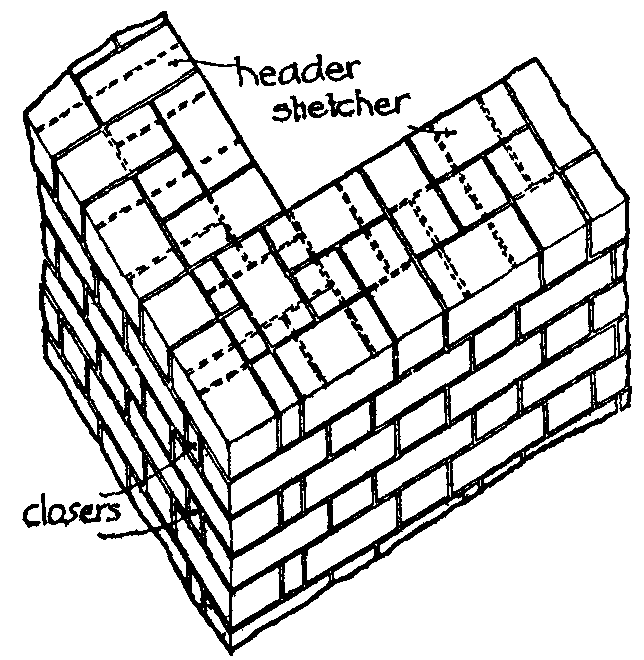
Another method of bonding brickwork, instead of placing the bricks in alternate courses of headers and stretchers, places them alternately as headers and stretchers in the same course, the appearance of the course being the same on each face. This is called "Flemish bond." Closers are necessary to this variety of bond. From fig. 6 it will be seen that, owing to the comparative weakness of the transverse tie, and the numbers of half bricks required to be used and the thereby increased number of joints, this bond is not so perfect nor so strong as English. The arrangements of the face joints, however, presenting in Flemish bond a neater appearance than in English bond, it is generally selected for the external walls of domestic and other buildings where good effect is desirable. In buildings erected for manufacturing and similar purposes, and in engineering works where the greatest degree of strength and compactness is considered of the highest importance, English bond should have the preference.
A compromise is sometimes made between the two above-mentioned bonds. For the sake of appearance the bricks are laid to form Flemish bond on the face, while the backing is of English bond, the object being to combine the best features of the two bonds. Undoubtedly the result is an improvement on Flemish bond, obviating as it does the use of bats in the interior of the wall. This method of bonding is termed "single Flemish bond," and is shown in fig. 7.
In stretching bond, which should only be used for walls half a brick in thickness, all the bricks are laid as stretchers, a half brick being used in alternate courses to start the bond. In work curved too sharply on plan to admit of the use of stretchers, and for footings, projecting mouldings and corbels, the bricks are all laid as headers, i.e. with their ends to the front, and their length across the thickness of the wall. This is termed "heading bond."
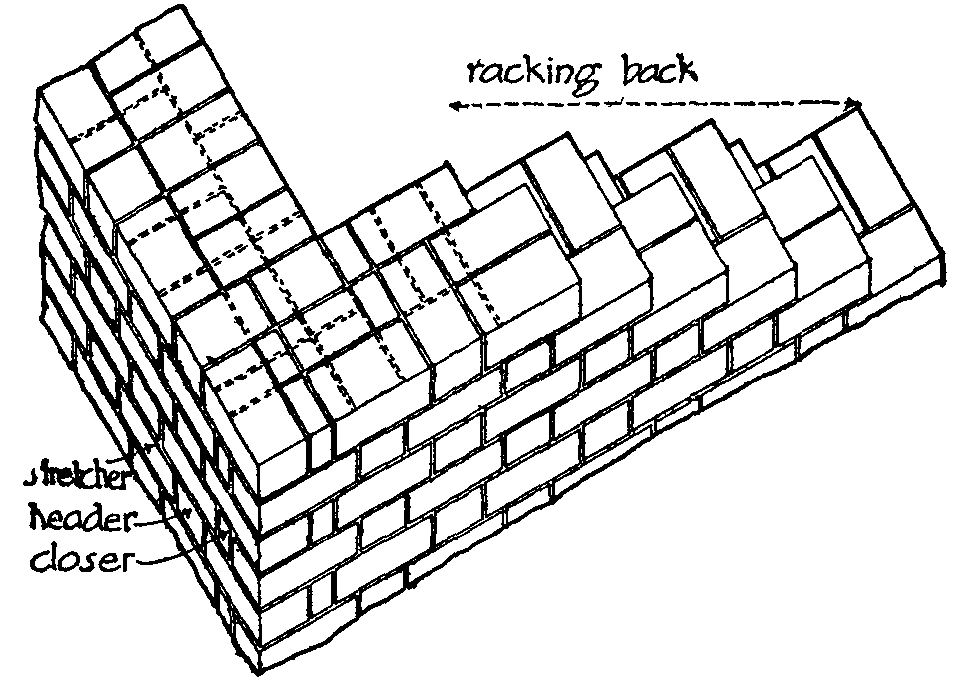
In thick walls, three bricks thick and upwards, a saving of labour is effected without loss of strength, by the adoption of "herring bone" or "diagonal bond" in the interior of the wall, the outer faces of the wall being built in English and Flemish bond. This mode should not be had recourse to for walls of a less thickness than 27 in., even that being almost too thin to admit of any great advantage from it.
Hoop-iron, about 1½ in. wide and 1/16 in. thick, either galvanized or well tarred and sanded to retard rusting, is used in order to obtain additional longitudinal tie. The customary practice is to use one strip of iron for each half-brick in thickness of the wall. Joints at the angles, and where necessary in the length, are formed by bending the ends of the strips so as to hook together. A patent stabbed iron now on the market is perforated to provide a key for the mortar.
A difficulty often arises in bonding when facing work with bricks of a slightly different size from those used in "backing," as it is technically termed. As it is, of course, necessary to keep all brickwork in properly levelled courses, a difference has to be made in the thickness of the mortar joints. Apart from the extra labour involved, this obviously is detrimental to the stability of the wall, and is apt to produce unequal settlement and cracking. Too much care cannot be taken to obtain both facing and backing bricks of equal size.
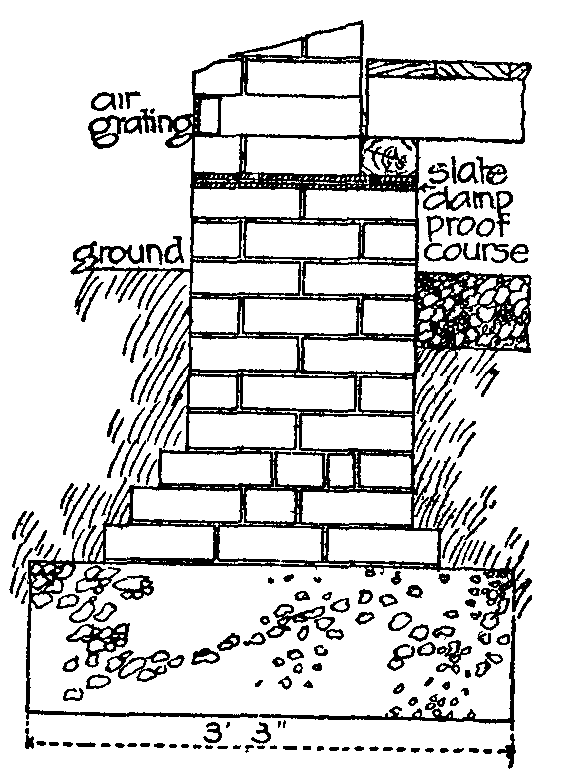
Dishonest bricklayers do not hesitate, when using for the face of a wall bricks of a quality superior to those used for the interior, to use "snapped headers," that is cutting the heading bricks in halves, one brick thus serving the purposes of two as regards outward appearance. This is a most pernicious practice, unworthy of adoption by any craftsman of repute, for a skin of brickwork 4½ in. thick is thus carried up with a straight mortar joint behind it, the proper bonding with the back of the wall by means of headers being destroyed.
American building acts describe the kind of bond to be used for ordinary walls, and the kind for faced walls. Tie courses also require an extra thickness where walls are perforated with over 30% of flues.
The importance for sanitary and other reasons of keeping walls dry is admitted by all who have observed the deleterious action of damp upon a building.
Walls are liable to become damp, (1) by wet rising up the wall from the earth; (2) by water soaking down from the top of the Prevention of damp. wall; (3) by rain being driven on to the face by wind. Dampness from the first cause may be prevented by the introduction of damp-proof courses or the construction of dry areas; from the second by means of a coping of stone, cement or other non-porous material; and from the third by covering the exterior with impervious materials or by the adoption of hollow walls.
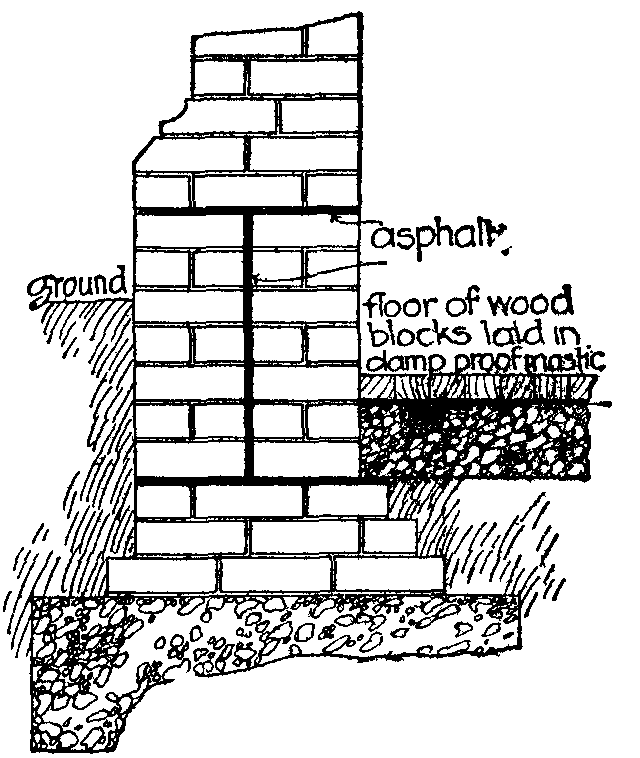
After the footings have been laid and the wall has been brought up to not less than 6 in. above the finished surface of the ground, and previous to fixing the plate carrying the ground floor, there should always be introduced a course of some damp-proof material to prevent the rise of moisture from the soil. There are several forms of damp-proof course. A very usual one is a double layer of roofing slates laid in neat Portland cement (fig. 8), the joints being well lapped. A course or two of Staffordshire blue bricks in cement is excellent where heavy weights have to be considered. Glazed stoneware perforated slabs about 2 in. thick are specially made for use as damp-proof courses. Asphalt (fig. 9) recently has come into great favour with architects; a layer ½ or ¾ in. thick is a good protection against damp, and not likely to crack should a settlement occur, but in hot weather it is liable to squeeze out at the joints under heavy weights. Felt covered with bitumen is an excellent substitute for asphalt, and is not liable to crack or squeeze out. Sheet lead is efficient, but very costly and also somewhat liable to squeezing. A damp-proof course has been introduced consisting of a thin sheet of lead sandwiched between layers of asphalt. Basement storeys to be kept dry require, besides the damp-proof course horizontally in the wall, a horizontal course, usually of asphalt, in the thickness of the floor, and also a vertical damp-proof course from a level below that of the floor to about 6 in. above the level of the ground, either built in the thickness of the wall or rendered on the outside between the wall and the surrounding earth (fig. 10).
By means of dry areas or air drains (figs. 11 and 12), a hollow [v.04 p.0526]space 9 in. or more in width is formed around those portions of the walls situated below the ground, the object being to prevent them from coming into contact with the brickwork of the main walls and so imparting its moisture to the building. Arrangements should be made for keeping the area clear of vermin and for ventilating and draining it. Dry areas, being far from sanitary, are seldom adopted now, and are being superseded by asphalt or cement applied to the face of the wall.
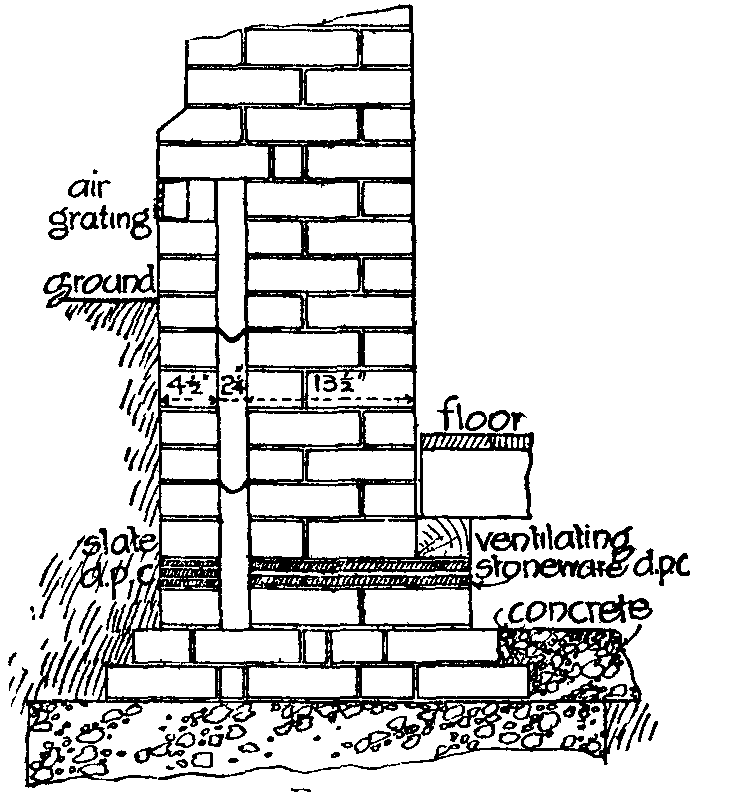
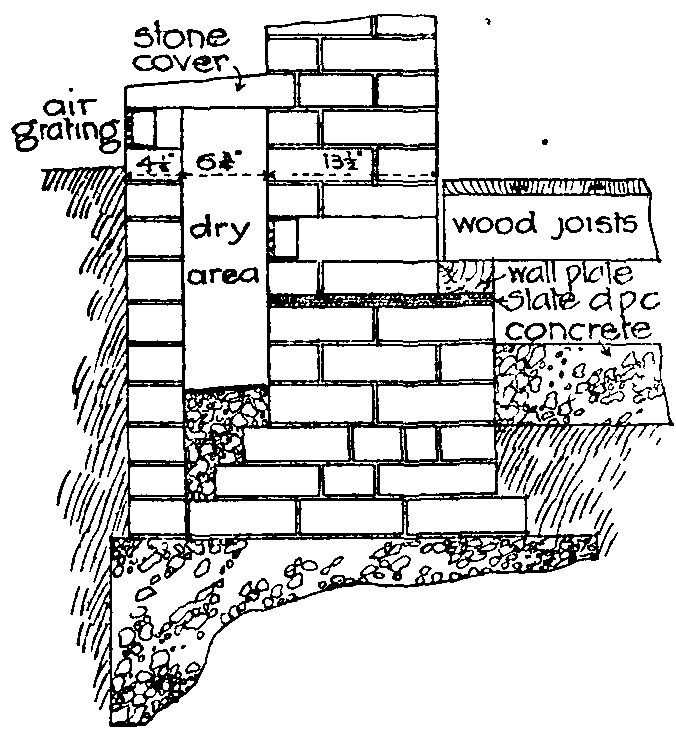

Moisture is prevented from soaking down from the top of the wall by using a covering of some impervious material in the form of a coping. This may consist of ordinary bricks set on edge in cement with a double course of tiles immediately below, called a "creasing," or of specially made non-porous coping bricks, or of stone, cast-iron, or cement sloped or "weathered" in order to throw the rain off.
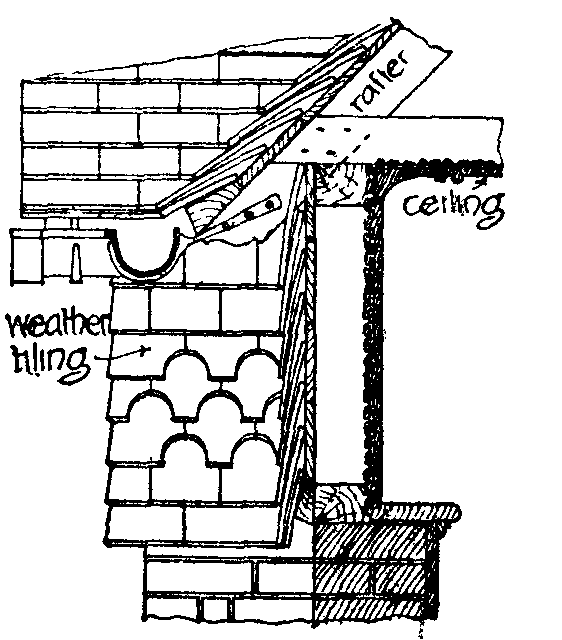
The exterior of walls above the ground line may be protected by coating the surface with cement or rough cast; or covering with slates or tiles fixed on battens in a similar manner to those on a roof (fig.13).
The use of hollow walls in exposed positions has already been referred to.
The by-laws dated 1891, made by the London County Council under section 16 of the Metropolis Management and Buildings Acts Amendment Act 1878, require that "every wall of a house or building shall have a damp course composed of materials impervious to moisture approved by the district surveyor, extending throughout its whole thickness at the level of not less than 6 in. below the level of the lowest floor. Every external wall or enclosing wall of habitable rooms or their appurtenances or cellars which abuts against the earth shall be protected by materials impervious to moisture to the satisfaction of the district surveyor..." "The top of every party-wall and parapet-wall shall be finished with one course of hard, well-burnt bricks set on edge, in cement, or by a coping of any other waterproof and fire-resisting material, properly secured."
Arches are constructions built of wedge-shaped blocks, which by reason of their shape give support one to another, and to the Arches. super-imposed weight, the resulting load being transmitted through the blocks to the abutments upon which the ends of the arch rest. An arch should be composed of such materials and designed of such dimensions as to enable it to retain its proper shape and resist the crushing strain imposed upon it. The abutments also must be strong enough to take safely the thrust of the weighted arch, as the slightest movement in these supports will cause deflection and failure. The outward thrust of an arch decreases as it approaches the semicircular form, but the somewhat prevalent idea that in the latter form no thrusting takes place is at variance with fact.
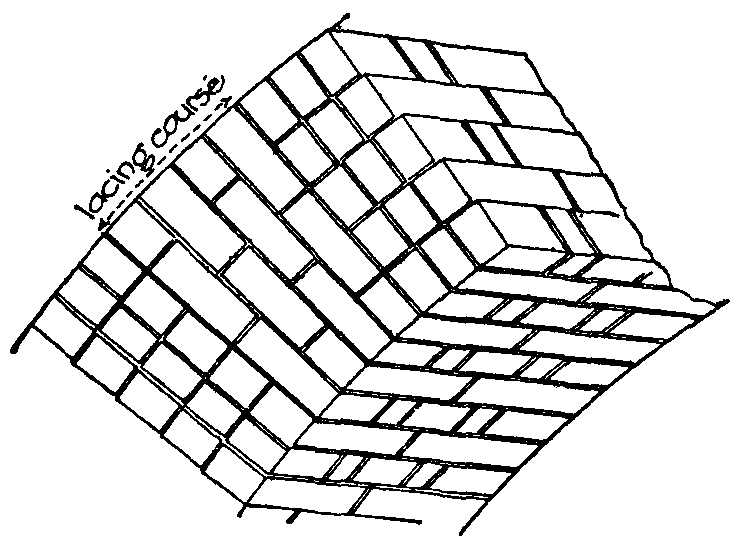
Arches in brickwork may be classed under three heads: plain arches, rough-cut and gauged. Plain arches are built of uncut bricks, and since the difference between the outer and inner periphery of the arch requires the parts of which an arch is made up to be wedge-formed, which an ordinary brick is not, the difference must be made in mortar, with the result that the joints become wedge-shaped. This obviously gives an objectionable inconsistency of material in the arch, and for this reason to obtain greatest strength it is advisable to build these arches in independent rings of half-brick thickness. The undermost rings should have thin joints, those of each succeeding ring being slightly thickened. This prevents the lowest ring from settling while those above remain in position, which would cause an ugly fissure. In work of large span bonding blocks or "lacing courses" should be built into the arch, set in cement and running through its thickness at intervals, care being taken to introduce the lacing course at a place where the joints of the various rings coincide. Stone blocks in the shape of a voussoir (fig. 14) may be used instead. Except for these lacing courses hydraulic lime mortar should be used for large arches, on account of its slightly accommodating nature.
Rough-cut arches are those in which the bricks are roughly cut with an axe to a wedge form; they are used over openings, such as doors and windows, where a strong arch of neat appearance is desired. The joints are usually made equal in width to those of the ordinary brickwork. Gauged arches are composed of specially made soft bricks, which are cut and rubbed to gauges or templates so as to form perfectly fitting voussoirs. Gauging is, of course, equally applicable to arches and walling, as it means no more than bringing every brick exactly to a certain form by cutting and rubbing. Gauged brickwork is set in lime putty instead of common mortar; the finished joints should not be more than 1/32 in. wide. To give stability the sides of the voussoirs are gauged out hollow and grouted in Portland cement, thus connecting each brick with the next by a joggle joint. Gauged arches, being for the most part but a half-brick in thickness on the soffit and not being tied by a bond to anything behind them—for behind them is the lintel with rough discharging arch over, supporting the remaining width of the wall—require to be executed with great care and nicety. It is a common fault with workmen to rub the bricks thinner behind than before to lessen the labour required to obtain a very fine face joint. This practice tends to make the work bulge outwards; it should rather be inverted if it be done at all, though the best work is that in which the bricks are gauged to exactly the same thickness at the back as at the front. The same fault occurs when a gauged arch is inserted in an old wall, on account of the difficulty of filling up with cement the space behind the bricks.
The bond of an arch obtains its name from the arrangement of headers and stretchers on its soffit. The under side of an arch built in English bond, therefore, will show the same arrangement as the face of a wall built in English bond. If the arch is in Flemish the soffit presents the same appearance as the elevation of a wall built in that bond.
It is generally held that the building of wood into brickwork Plates. should as far as is possible be avoided. Wall plates of wood are, however, necessary where wood joists are used, and where these plates may not be supported on corbels of projecting brickwork or iron they must be let flush into the wall, taking the place of a course of bricks. They form a uniform bed for the joists, to which easy fixing is obtained. The various modes adopted for resting and fixing the ends of joists on walls are treated in the article Carpentry.
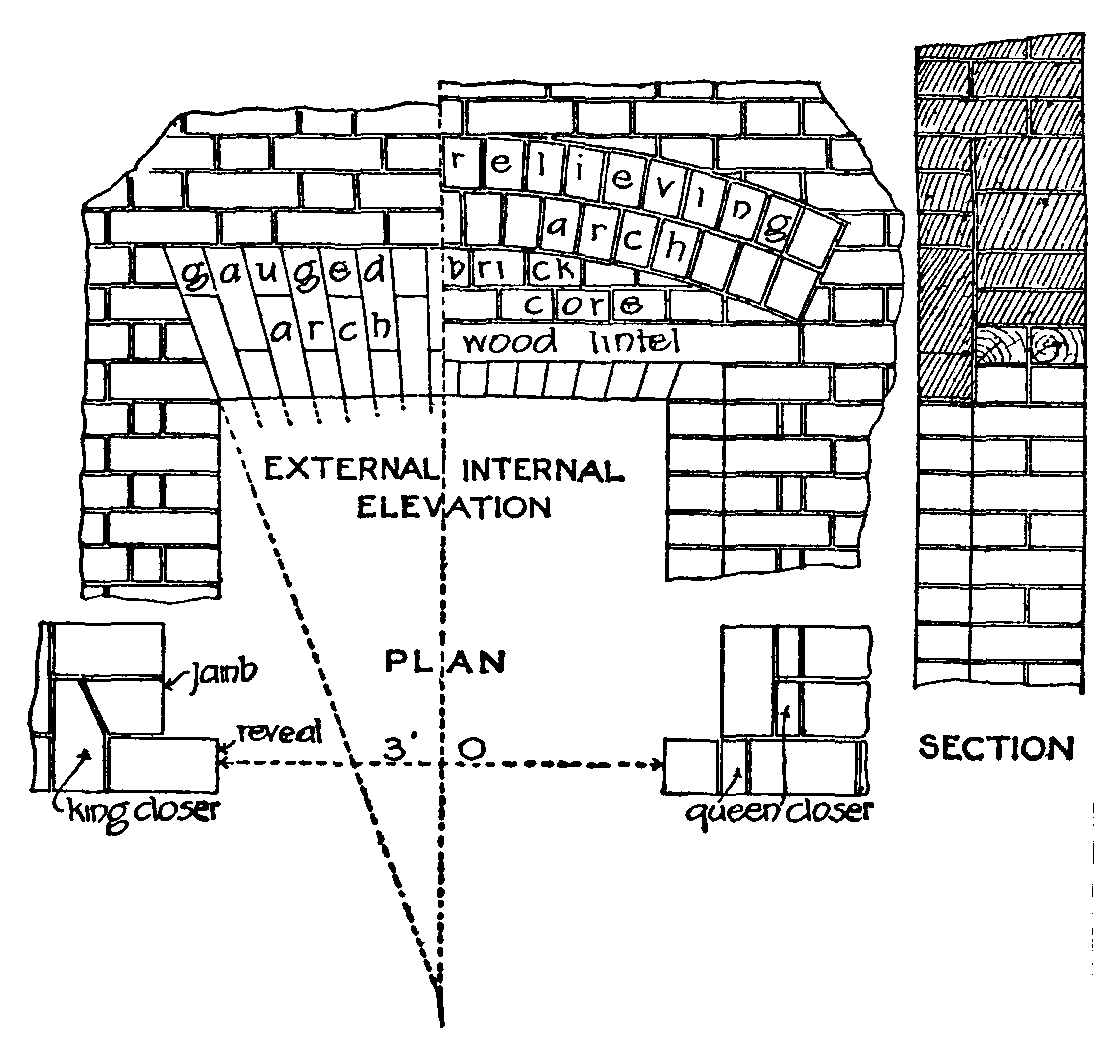
Lintels, which may be of iron, steel, plain or reinforced concrete, or stone, are used over square-headed openings instead of or in conjunction with arches. They are useful to preserve the square form and receive the joiners' fittings, but except when made of steel or of concrete reinforced with steel bars, they should have relieving arches turned immediately over them (Fig.15).
"Fixing bricks" were formerly of wood of the same size as the ordinary brick, and built into the wall as required for fixing joinery. Owing to their liability to shrinkage and decay, their use is now practically abandoned, their place being taken by bricks of coke-breeze concrete, which do not shrink or rot and hold fast nails or screws driven into them. Another method often adopted for [v.04 p.0527]providing a fixing for joinery is to build in wood slips the thickness of a joint and 4½ in. wide. When suitable provision for fixing has not been made, wood plugs are driven into the joints of the bricks. Great care must be taken in driving these in the joints of reveals or at the corners of walls, or damage may be done.
The name "brick-ashlar" is given to walls faced with ashlar stonework backed in with brickwork. Such constructions are liable in an aggravated degree to the unequal settling and its attendant evils pointed out as existing in walls built with different qualities of bricks. The outer face is composed of unyielding stone with few and very thin joints, which perhaps do not occupy more than a hundredth part of its height, while the back is built up of bricks with about one-eighth its height composed of mortar joints, that is, of a material that by its nature and manner of application must both shrink in drying and yield to pressure. To obviate this tendency to settle and thus cause the bulging of the face or failure of the wall, the mortar used should be composed of Portland cement and sand with a large proportion of the former, and worked as stiff as it conveniently can be. In building such work the stones should be in height equal to an exact number of brick courses. It is a common practice in erecting buildings with a facing of Kentish rag rubble to back up the stonework with bricks. Owing to the great irregularity of the stones, great difficulty is experienced in obtaining proper bond between the two materials. Through bonding stones or headers should be frequently built in, and the whole of the work executed in cement mortar to ensure stability.
Not the least important part of the bricklayer's art is the formation of chimney and other flues. Considerable skill is required in Chimneys and flues. gathering-over properly above the fireplace so as to conduct the smoke into the smaller flue, which itself requires to be built with precision, so that its capacity may not vary in different parts. Bends must be made in gradual curves so as to offer the least possible resistance to the up-draught, and at least one bend of not less than 60° should be formed in each flue to intercept down-draughts. Every fireplace must have a separate flue. The collection of a number of flues into a "stack" is economical, and tends to increase the efficiency of the flues, the heat from one flue assisting the up-draught in those adjoining it. It is also desirable from an aesthetic point of view, for a number of single flue chimneys sticking up from various parts of the roof would appear most unsightly. The architects of the Elizabethan and later periods were masters of this difficult art of treating a stack or stacks as an architectural feature. The shaft should be carried well above the roof, higher, if possible, than adjacent buildings, which are apt to cause down-draught and make the chimney smoke. When this is found impossible, one of the many forms of patent chimney-pots or revolving cowls must be adopted. Each flue must be separated by smoke-proof "withes" or divisions, usually half a brick in thickness; connexion between them causes smoky chimneys. The size of the flue for an ordinary grate is 14×9 in.; for a kitchen stove 14×14 in. The outer wall of a chimney stack may with advantage be made 9 in. thick. Fireclay tubes, rectangular or circular in transverse section, are largely used in place of the pargetting; although more expensive than the latter they have the advantage in point of cleanliness and durability. Fireplaces generally require more depth than can be provided in the thickness of the wall, and therefore necessitate a projection to contain the fireplace and flues, called the "chimney breast." Sometimes, especially when the wall is an external one, the projection may be made on the back, thus allowing a flush wall in the room and giving more space and a more conveniently-shaped room. The projection on the outside face of the wall may be treated as an ornamental feature. The fireplace opening is covered by a brick relieving arch, which is fortified by wrought-iron bar from ½ to ¾ in. thick and 2 to 3 in. wide. It is usually bent to a "camber," and the brick arch built upon it naturally takes the same curve. Each end is "caulked," that is, split longitudinally and turned up and down. The interior of a chimney breast behind the stove should always be filled in solid with concrete or brickwork. The flooring in the chimney opening is called the "hearth"; the back hearth covers the space between the jambs of the chimney breast, and the front hearth rests upon the brick "trimmer arch" designed to support it. The hearth is now often formed in solid concrete, supported on the brick wall and fillets fixed to the floor joists, without any trimmer arch and finished in neat cement or glazed tiles instead of stone slabs.
Tall furnace chimneys should stand as separate constructions, unconnected with other buildings. If it is necessary to bring other work close up, a straight joint should be used. The shaft of the chimney will be built "overhand," the men working from the inside. Lime mortar is used, cement being too rigid to allow the chimney to rock in the wind. Not more than 3 ft. in height should be erected in one day, the work of necessity being done in small portions to allow the mortar to set before it is required to sustain much weight. The bond usually adopted is one course of headers to four of stretchers. Scaffolding is sometimes erected outside for a height of 25 or 30 ft., to facilitate better pointing, especially where the chimney is in a prominent position. The brickwork at the top must, according to the London Building Act, be 9 in. thick (it is better 14 in. in shafts over 100 ft. high), increasing half a brick in thickness for every additional 20 ft. measured downwards. "The shaft shall taper gradually from the base to the top at the rate of at least 2½ in. in 10 ft. of height. The width of the base of the shaft if square shall be at least one-tenth of the proposed height of the shaft, or if round or any other shape, then one-twelfth of the height. Firebricks built inside the lower portion of the shaft shall be provided, as additional to and independent of the prescribed thickness of brickwork, and shall not be bonded therewith." The firebrick lining should be carried up from about 25 ft. for ordinary temperatures to double that height for very great ones, a space of 1½ to 3 in. being kept between the lining and the main wall. The lining itself is usually 4½ in. thick. The cap is usually of cast iron or terra-cotta strengthened with iron bolts and straps, and sometimes of stone, but the difficulty of properly fixing this latter material causes it to be neglected in favour of one of the former. (See a paper by F.J. Bancroft on "Chimney Construction," which contains a tabulated description of nearly sixty shafts, Proc. Civ. and Mech. Eng. Soc., December 1883.)
The work of laying bricks or tiles as paving falls to the lot of the bricklayer. Paving formed of ordinary bricks laid flat or on their Brick paving. edges was once in general use, but is now almost abandoned in favour of floors of special tiles or cement paving, the latter being practically non-porous and therefore more sanitary and cleaner. Special bricks of extremely hard texture are made for stable and similar paving, having grooves worked on the face to assist drainage and afford good foothold. A bed of concrete 6 in. thick is usually provided under paving, or when the bricks are placed on edge the concrete for external paving may be omitted and the bricks bedded in sand, the ground being previously well rammed. The side joints of the bricks are grouted in with lime or cement. Dutch clinkers are small, hard paving bricks burned at a high temperature and of a light yellow colour; they are 6 in. long, 3 in. wide, 1½ in. thick. A variety of paving tile called "oven tiles" is of similar material to the ordinary red brick, and in size is 10 or 12 in. square and 1 to 2 in. thick. An immense variety of ornamental paving and walling tiles is now manufactured of different colours, sizes and shapes, and the use of these for lining sculleries, lavatories, bathrooms, provision shops, &c., makes for cleanliness and improved sanitary conditions. Besides, however, being put to these uses, tiles are often used in the ornamentation of buildings, externally as well as internally.
Mosaic work is composed of small pieces of marble, stone, glass or pottery, laid as paving or wall lining, usually in some ornamental pattern or design. A firm bed of concrete is required, the pieces of [v.04 p.0528]material being fixed in a float of cement about half or three-quarters of an inch thick. Roman mosaic is formed with cubes of marble of various colours pressed into the float. A less costly paving may be obtained by strewing irregularly-shaped marble chips over the floated surface: these are pressed into the cement with a plasterer's hand float, and the whole is then rolled with an iron roller. This is called "terazzo mosaic." In either the Roman or terazzo method any patterns or designs that are introduced are first worked in position, the ground-work being filled in afterwards. For the use of cement for paving see Plaster.
The principal publications on brickwork are as follows:—Rivington, Notes on Building Construction, vols. i. ii. iii.; Col. H.E. Seddon, Aide Memoir, vol. ii.; Specification; J.P. Allen, Building Construction; F.E. Kidder, Building Construction and Superintendence, part i. (1903); Longmans & Green, Building Construction; E. Dobson, Bricks and Tiles; Henry Adams, Building Construction; C.F. Mitchell, Building Construction, vols. i. ii.; E. Street, Brick and Marble Architecture in Italy.
(J. Bt.)